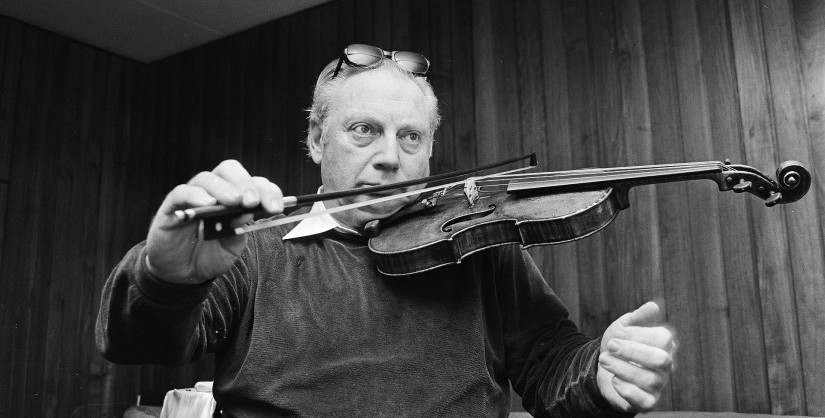
Isaac Stern
Isaac Stern, an award-winning violinist and conductor, was a key figure in saving Carnegie Hall from demolition and developing it into the multi-purpose concert venue and education center that it is today.
Isaac Stern, an award-winning violinist and conductor, was born in the Soviet Ukraine (now part of Poland) on July 21, 1920. After moving to San Francisco when he was 14 months old, he began his musical training, first under his mother and later at the San Francisco Conservatory of Music. Widely known for his recordings, performances, and adeptness in discovering new musical talent, Stern was also influential in spearheading the campaign to save Carnegie Hall from demolition in the 1950s (culminating in a legislative bill protecting the building in 1960).1 Stern’s involvement with the Hall began after his debut there in 1943 and lasted until his death in New York City on September 22, 2001, at the age of 81.2
In 1955 the owner of Carnegie Hall put the building up for sale and rumors spread that a real estate development company planned to demolish the Hall and replace it with a high-rise office building. In 1956 Isaac Stern helped form the Committee to Save Carnegie Hall, which successfully blocked the sale of the building, though their methods were undisclosed. However, on January 5, 1960, the owner once again announced that Carnegie Hall would be demolished after the New York Philharmonic, the Hall’s major tenant, decided to move to the newly-constructed Lincoln Center. Many famous musicians, including Stern, joined the overwhelming support for the protection of the building. Citing his recent series of appearances at Carnegie Hall in a discussion advocating for the building's protection with philanthropist Jacob M. Kaplan, Stern mentioned how sad he was that these performances could be his last at the venue. This meeting led to a new effort funded by Kaplan and spearheaded by Stern to save the hall from demolition.3 With Kaplan’s financial and administrative assistance, and support from New York State Senator MacNeil Mitchell, Stern became a vital force in rallying support, enlisting other major supporters that included Eleanor Roosevelt, Fritz Kreisler, Jascha Heifetz, Arthur Rubinstein, Dame Myra Hess, Van Cliburn, Leopold Stokowski, Marian Anderson, Fritz Reiner, and many other musicians and philanthropists.4
Stern gathered civic leaders at his home in January 1960 to organize the Citizens Committee for Carnegie Hall. Their strategy was to create a not-for-profit entity to save, preserve, and operate the hall by attaining timely government intervention.5 Another obstacle involved addressing concerns that the City would not be able to support two concert halls, Carnegie Hall and Lincoln Center. The committee eventually convinced Mayor Robert F. Wagner that Carnegie Hall should "be saved to serve as a national center for teaching music and the development of young artists" and that it would not compete with Lincoln Center.6 The 1956 Bard Act provided a strong legal base, and the 1960 Carnegie Hall Bill (passed by Senator MacNeil Mitchell and championed by Stern) also helped save the building by permitting New York City to acquire buildings with "special character, or special historical or aesthetic interest or value," by purchase or condemnation. Stern and the committee did not go public with these efforts until they had convinced a majority of the council and garnered their support for the Bill.7 On June 10, 1960 the New York City Board of Estimate approved the City's purchase of Carnegie Hall for $5 million, providing another $100,000 for improvements.8 New York City remains the owner of the structure. After the legislation was passed, and the Carnegie Hall Corporation was chartered, Stern was elected as president, a position he held until his death.9 In this role Stern was involved in campaigning for funds and running the hall. As an integral part of the corporation, Isaac Stern also played a central role in a major restoration in 1986 and in the celebration of its centenary in 1991. The main concert hall was renamed the Isaac Stern Auditorium in honor of his efforts in 1997.10
- Anthony C. Wood. Preserving New York: Winning the Right to Protect a City's Landmarks. (New York: Routledge, 2007).
- Stern, Isaac, and Chaim Potok. My First 79 Years. 1st trade ed. New York: Alfred A. Knopf, 1999.
- Oral History with Isaac Stern
New York Preservation Archive Project
174 East 80th Street
New York, NY 10075
Tel: (212) 988-8379
Email: info@nypap.org
-
“Violinist Isaac Stern Dies at 81”, BBC News, 23 September 2001.
-
Leslie Bennetts, “HOW CARNEGIE HALL HAS EVOLVED INTO A ‘BUSINESS'”, The New York Times, 30 May 1983.
-
“Isaac Stern and Saving of the Hall”, Carnegie Hall.org. 24 November 2014.
-
Allan Kozinn. “Violinist Isaac Stern Dies at 81; Led Efforts to Save Carnegie Hall”, The New York Times, 22 September 2001.
-
Anthony C. Wood, Preserving New York: Winning the Right to Protect a City’s Landmarks (New York: Routledge, 2008), Pg. 253-254.
-
“Isaac Stern and Saving of the Hall”, Carnegie Hall.org. 24 November 2014.
-
Mentioned in Isaac Stern Oral History Interview.
-
“Isaac Stern and Saving of the Hall”, Carnegie Hall.org., 24 November 2014.
-
“The A to Z of Carnegie Hall: S Is for Stern”, Carnegie Hall.org., 24 November 2014.
-
Allan Kozinn. “Violinist Isaac Stern Dies at 81; Led Efforts to Save Carnegie Hall”, The New York Times, 22 September 2001.